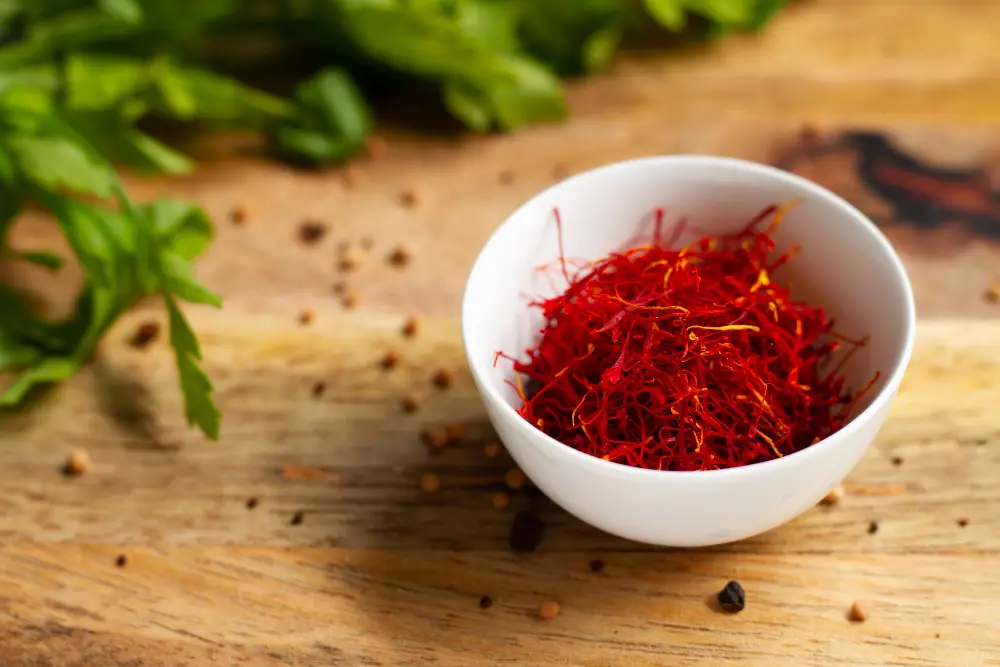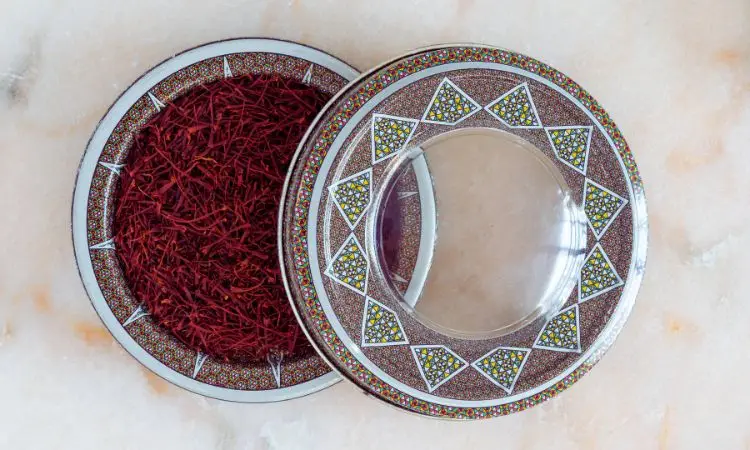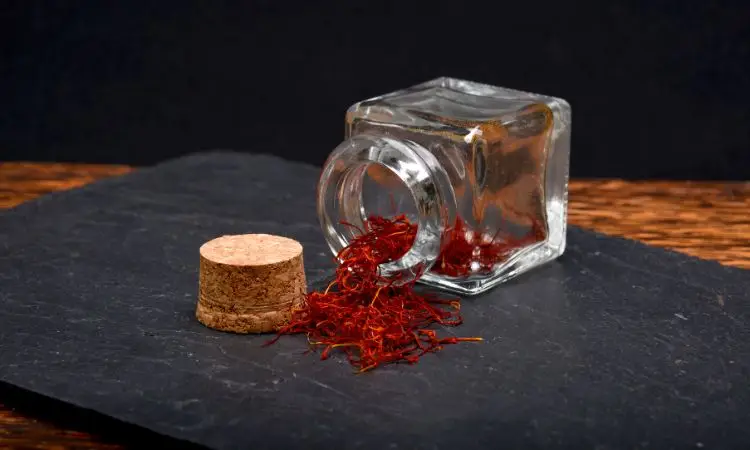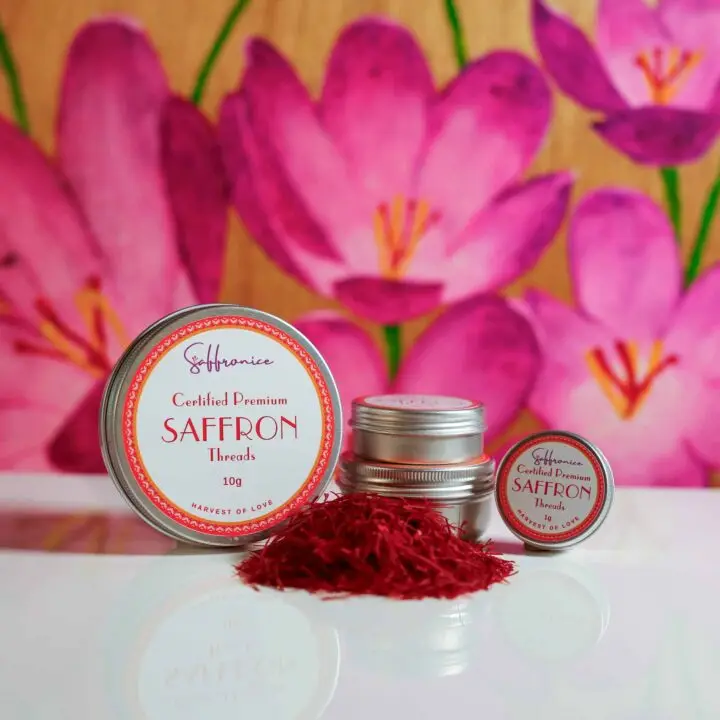Saffron, the vibrant red-gold spice, holds a distinguished position in Traditional Chinese Medicine (TCM). Known as “红花” (hóng huā) or the “red gold,” this precious spice has been woven into the fabric of Chinese healing practices for over a millennium. What makes this exotic spice so highly valued and integral to ancient Chinese medicinal traditions?
Saffron’s journey through Chinese medical history has been both fascinating and transformative. From its first documented appearance during the Tang dynasty to its official recognition in the Chinese Pharmacopoeia, saffron’s unique chemical composition and diverse therapeutic applications have cemented its status as a treasured ingredient in traditional healing.
We will explore saffron’s historical journey, therapeutic properties according to TCM theory, and how modern research validates ancient wisdom. Join us as we uncover why saffron continues to be a cornerstone of Chinese medicine.
🔑 Key Takeaways:
- Saffron has been integral to Traditional Chinese Medicine since the Tang dynasty (7th-8th century CE)
- TCM values saffron for its ability to invigorate blood circulation and regulate Qi energy
- The unique chemical compounds in saffron provide scientifically validated therapeutic effects
- Modern research confirms many traditional applications, bridging ancient wisdom with contemporary medicine
- Quality authentication methods ensure therapeutic efficacy in both traditional and modern applications

Introduction to Saffron: The Red Gold of Traditional Medicine
Saffron has captivated humanity for over 3,500 years, earning its place in traditional medicine systems across continents. Derived from the crimson stigmas of the Crocus sativus L. flower, this remarkable spice is celebrated for its luminous golden color, distinctive aroma, and profound health benefits. Its designation as “red gold” reflects both its extraordinary value and its enduring significance in global healing traditions.
Historical Significance in Ancient Healing
Saffron’s medicinal legacy extends deep into antiquity, with documented uses by Greco-Romans, Egyptians, Persians, Indians, Chinese, and Europeans. This cross-cultural adoption of saffron in ancient medicine demonstrates the universal recognition of its therapeutic properties. Throughout millennia, healers across diverse traditions have turned to saffron as a versatile remedy for physical and emotional ailments.
The spice’s journey along ancient trade routes facilitated not only the exchange of goods but also the sharing of medical knowledge. As saffron traveled from its Mediterranean origins eastward along the Silk Road, it absorbed new applications and theoretical frameworks, enriching the medical traditions of each culture it encountered.
TCM Perspective: In Chinese medicine, saffron is classified as having a warm nature with sweet and slightly bitter tastes. It enters the Heart and Liver meridians, making it particularly valuable for addressing blood stagnation and emotional imbalances—concepts central to TCM diagnosis and treatment.
The Premium Status of Saffron in Medicine
Saffron’s prestigious status in medical practice stems directly from its remarkable scarcity and labor-intensive production. Harvesting requires 70,000 to 200,000 delicate flowers to produce just one kilogram of dried stigmas. This extraordinary effort translates to premium pricing, yet practitioners across cultures have consistently deemed the investment worthwhile given saffron’s exceptional therapeutic benefits.
The meticulous hand-harvesting process, unchanged for millennia, ensures the preservation of saffron’s delicate bioactive compounds. Each stigma must be carefully plucked at precisely the right moment of bloom—a narrow window that demands constant vigilance and skilled hands.
Global Production and Value
Iran dominates global saffron production, contributing over 90% of the world’s supply. However, cultivation has expanded to diverse regions including Greece, Morocco, Spain, India, Australia, Canada, the United States, and China. In China, where saffron commands approximately 100 RMB (15-16 USD) per gram, the spice’s “red gold” moniker reflects both its monetary value and medicinal importance.
| Country | Saffron Production (Tons) | Notable Characteristics |
|---|---|---|
| Iran | 404 | Largest producer, known for high quality |
| Greece | 7 | Premium grades with intense aroma |
| Morocco | 6 | Traditional cultivation methods |
| Spain | 3 | Renowned for the Mancha variety |
| India | 2 | Kashmir saffron is highly prized |
Food Scientist’s Note: The terroir—the environmental factors affecting cultivation—significantly influences saffron’s chemical composition. Climate, soil composition, altitude, and harvesting techniques all contribute to variations in crocin, safranal, and picrocrocin content, which determines therapeutic efficacy.
Understanding Saffron’s Botanical Properties
Saffron originates exclusively from Crocus sativus L., a member of the Iridaceae family distinguished by its autumn-blooming purple flowers and brilliant crimson stigmas. These stigmas, meticulously hand-harvested and carefully dried, transform into the precious spice that has captivated healers and chefs for millennia.
Among approximately 80 species in the Crocus genus, only Crocus sativus produces true saffron. This botanical exclusivity contributes significantly to the spice’s rarity and value. The plant’s unique characteristics and cultivation requirements have shaped human agricultural practices and trade patterns for centuries.
Unique Growth Characteristics
Crocus sativus possesses several distinctive botanical features that set it apart from its wild relatives:
Genetic Peculiarity: The plant is a sterile triploid, meaning it possesses three sets of chromosomes rather than the typical two. This genetic configuration prevents sexual reproduction through seeds, making cultivation entirely dependent on vegetative propagation through corm division.
Corm Reproduction: Each mature corm produces several daughter corms annually, which growers separate and replant to maintain and expand cultivation. This asexual reproduction ensures genetic uniformity but also means every saffron crocus worldwide descends from the same ancient domesticated stock.
Growth Cycle: The corms remain dormant through spring and summer, developing underground until autumn when they suddenly produce their ephemeral purple flowers. This brief blooming window—typically 15-20 days—demands intensive labor during harvest season.
| Saffron Cultivation Statistics | Value |
|---|---|
| Annual Global Production | Approximately 265 tons |
| Total Cultivation Land | Around 90,000 acres worldwide |
| Yield per Acre | Approximately 6 pounds per year |
| Labor Required per Pound | 170-200 hours of skilled work |
Chef’s Professional Tip: The characteristic bitter-sweet taste and vibrant color intensity of saffron correlate directly with the concentration of bioactive compounds. High-quality saffron threads should be deep crimson-red with minimal yellow style attached, indicating careful processing that preserves therapeutic potency.
Historical Cultivation Regions
Saffron has been cultivated across the region spanning from Greece to Persia for 35 centuries, with its medicinal applications documented throughout this extensive history. The spice’s westward journey along ancient trade routes introduced it to new cultures, while its eastward expansion brought it into the orbit of Chinese civilization during the Tang dynasty.
The spice’s introduction to China represented more than simple botanical exchange—it catalyzed a synthesis of medical theories, with Chinese practitioners interpreting saffron’s effects through the lens of TCM principles while drawing on accumulated knowledge from Western and Central Asian traditions.
The Journey of Saffron in Chinese Medicine History
Saffron’s integration into Traditional Chinese Medicine represents a fascinating chapter in the history of cross-cultural medical exchange. The spice’s journey from exotic import to officially recognized medicinal herb spans over a millennium of clinical observation and theoretical integration.
First Documentation in the Tang Dynasty
The earliest recorded mention of saffron in Chinese medical literature appears in the “Ben Cao Shi Yi” (Supplement to the Materia Medica) compiled in 741 CE during the Tang dynasty. This period marked a golden age of cultural exchange along the Silk Road, facilitating the introduction of numerous foreign medicines into Chinese practice.
The Tang dynasty’s cosmopolitan character and openness to foreign innovations created ideal conditions for saffron’s acceptance. Chinese physicians, renowned for their pragmatic approach to therapeutic efficacy, tested saffron extensively and gradually integrated it into their pharmaceutical armamentarium.
Historical Context: The Tang dynasty (618-907 CE) witnessed unprecedented international trade and cultural exchange. Buddhist monks, merchants, and diplomats traveling along the Silk Road brought not only goods but also medical knowledge from Persia, India, and Central Asia into China.
Evolution Through the Chinese Pharmacopoeia
Following its initial documentation, saffron’s status in Chinese medicine evolved gradually through centuries of clinical use and theoretical refinement. Chinese herbalists developed a detailed understanding of the spice’s properties, appropriate dosages, suitable combinations with other herbs, and specific indications for use.
Key Milestones in Recognition:
- 8th-12th Centuries: Gradual adoption by TCM practitioners based on clinical observations
- Ming Dynasty (1368-1644): Increased documentation in major medical texts
- Qing Dynasty (1644-1912): Refinement of dosage guidelines and combination formulas
- 20th Century: Scientific investigation of traditional uses
- 2005: Official inclusion in the Chinese Pharmacopoeia
The 2005 inclusion in the “Zhong Guo Yao Dian” (Chinese Pharmacopoeia) represented a significant milestone, providing official recognition and standardization of saffron’s medicinal use. This inclusion validated centuries of traditional practice with modern quality standards and scientific understanding.
Modern Recognition in TCM
Contemporary TCM practice continues to value saffron while benefiting from modern research that validates traditional applications. The integration of scientific methodology with traditional wisdom has strengthened confidence in saffron’s therapeutic efficacy while clarifying optimal uses and potential contraindications.
Interesting Historical Note: Chinese and Tibetan naming conventions initially created confusion about saffron’s origins. The Chinese name “藏红花” (zàng hóng huā) translates as “Tibetan red flower,” leading many to believe saffron was indigenous to Tibet. However, this nomenclature reflects trade routes rather than botanical origins—saffron reached inland China through Tibetan trading networks, hence the attribution.
Cultivation and Harvesting Methods
Saffron’s reputation as “red gold” directly reflects the extraordinary labor and precision required throughout its cultivation and harvest. Harvesting methods developed over millennia remain largely unchanged, as attempts at mechanization consistently compromise the delicate stigmas’ integrity and therapeutic potency.
Optimal Growing Conditions
Successful saffron cultivation demands specific environmental conditions:
Climate Requirements:
- Hot, dry summers for corm dormancy and development
- Cold winters (below 0°C) for proper vernalization
- Mild, rainy autumn for flowering
- Annual rainfall of 300-400mm, ideally concentrated in spring and autumn
- Minimal rainfall during dormancy and harvest
Soil Specifications:
- Well-drained, light-textured soils (sandy loam or loamy sand)
- pH between 7.0 and 8.0 (slightly alkaline)
- Good organic matter content (2-3%)
- Depth of at least 30cm for proper corm development
Major cultivation regions like Iran, Kashmir, and the Mediterranean basin naturally provide these conditions, though careful soil management allows cultivation in other suitable areas.
The Harvest Window
The saffron flower’s ephemeral nature creates one of agriculture’s most demanding harvest schedules. Flowers bloom for only 15-20 days each autumn, typically in November, with each flower opening for just a single day. This narrow window requires the mobilization of entire communities during peak harvest.
Optimal Harvest Timing: Flowers must be picked at dawn before full opening, when stigmas retain maximum aroma and color. As the day progresses and flowers fully open, exposure to sunlight begins degrading delicate compounds, reducing therapeutic quality.
Labor-Intensive Processing
Following harvest, immediate processing preserves saffron’s therapeutic compounds:
| Processing Stage | Recommended Specifications |
|---|---|
| Flower Collection | Before flowers fully open, typically at dawn |
| Stigma Separation | Within hours of picking, entirely by hand |
| Initial Drying | Controlled temperature (35-45°C) for 20-30 minutes |
| Final Drying | Continued gentle drying to 10-12% moisture content |
| Storage | Airtight containers, cool, dark conditions |
Food Scientist’s Note: The drying process critically influences final quality. Too much heat destroys volatile compounds like safranal, while insufficient drying allows enzymatic degradation and mold growth. Traditional methods often achieve better preservation than industrial approaches due to careful temperature control.
Field Management Requirements
| Cultivation Parameter | Recommended Specification |
|---|---|
| Ploughing Depth | Minimum 20cm with soil depth of at least 30cm |
| Manure Application | 5-8 tons per mu of decomposed organic matter |
| Nitrogen Fertilizer | 20-40 kg elemental nitrogen per mu |
| Phosphate Fertilizer | 30-50 kg superphosphate per mu |
| Potassium Fertilizer | 15-30 kg elemental potassium per mu |
| Corm Planting Rate | 500-800 kg per mu (Chinese measurement) |
These intensive cultivation requirements explain saffron’s premium pricing—quality production demands significant investment of labor, knowledge, and resources at every stage from planting through harvest.
Saffron in Chinese Medicine: Core Principles and Applications
In Traditional Chinese Medicine, saffron occupies a unique position due to its potent effects on blood circulation and Qi flow. TCM practitioners have developed a sophisticated understanding of how to leverage saffron’s properties within the theoretical framework of meridians, organ systems, and energetic qualities.
Traditional Usage Methods
TCM employs various preparation methods to optimize saffron’s therapeutic effects:
Decoctions (Tang): Saffron threads steeped in hot water, often combined with complementary herbs according to specific formulas. This traditional method extracts water-soluble compounds while preserving heat-sensitive components.
Pills and Powders (Wan and San): Ground saffron incorporated into pill or powder formulations for convenient dosing and combination with other medicinal ingredients.
Wine Preparations (Jiu): Saffron macerated in rice wine or spirits, facilitating the extraction of both water and alcohol-soluble compounds while leveraging the wine’s warming, circulating properties in TCM theory.
External Applications: Topical preparations for specific conditions, particularly in dermatology and pain management.
Chef’s Professional Tip: When preparing saffron decoctions at home, never boil the threads directly. Instead, steep them in water just below boiling (around 80-90°C) for 10-15 minutes to preserve delicate aromatic compounds while extracting therapeutic constituents.
Therapeutic Properties in TCM Theory
TCM classifies saffron according to several key characteristics:
Nature and Taste:
- Nature: Warm (温, wēn)
- Taste: Sweet and slightly bitter (甘微苦, gān wēi kǔ)
- Meridian Entry: Heart and Liver (入心肝经, rù xīn gān jīng)
Primary Functions:
- Invigorates blood circulation (活血, huó xuè)
- Removes blood stasis (化瘀, huà yū)
- Cools blood and detoxifies (凉血解毒, liáng xuè jiě dú)
- Relieves depression and calms the spirit (解郁安神, jiě yù ān shén)
These properties make saffron particularly valuable for conditions involving blood stagnation, emotional distress, menstrual irregularities, and cardiovascular concerns—all core areas of TCM practice.
Clinical Applications
TCM practitioners employ saffron for diverse health concerns:
Cardiovascular Health: Improves blood circulation, supporting heart health and addressing conditions attributed to blood stasis. Modern research on heart health benefits validates this traditional application.
Women’s Health: Regulates menstruation, alleviates dysmenorrhea, and addresses postpartum complications. Saffron’s effects on blood circulation make it particularly valuable in gynecological practice.
Mental and Emotional Well-being: Addresses depression and anxiety by “moving stagnant Qi” and calming the spirit. TCM views emotional disturbances as often rooted in disrupted energy flow, which saffron helps restore.
Digestive Health: Supports digestive function and relieves gastrointestinal discomfort, particularly when related to Qi stagnation.
Dosage Guidelines According to TCM
Traditional dosing reflects a careful balance between therapeutic efficacy and safety:
| Application | Typical Dosage Range | Duration |
|---|---|---|
| General tonic use | 0.3-1 gram daily | Extended periods safe |
| Acute conditions | 1-3 grams daily | Short-term only |
| Decoction preparation | 0.5-2 grams per formula | As prescribed |
| Powder form | 0.3-0.5 grams per dose | 2-3 times daily |
For comprehensive dosage guidance, consultation with qualified TCM practitioners ensures appropriate individualized recommendations.
Important Contraindications: TCM texts warn against saffron use during pregnancy due to its strong blood-invigorating properties, which may stimulate uterine contractions. Individuals should also review potential side effects before beginning supplementation.

Chemical Composition and Active Compounds
Saffron’s remarkable therapeutic properties stem from its extraordinarily complex chemical composition, containing over 150 identified compounds. This molecular diversity explains both the spice’s versatility in traditional medicine and its continued relevance in modern pharmaceutical research.
Primary Bioactive Constituents
Crocins (Carotenoid Glycosides): These water-soluble carotenoid derivatives constitute the largest proportion of saffron’s active compounds, typically comprising 13-17% of dry weight. Crocins provide saffron’s characteristic golden color and demonstrate potent antioxidant properties.
Crocetin (Carotenoid Aglycone): The core structure of crocins, crocetin, demonstrates enhanced bioavailability and crosses the blood-brain barrier efficiently. This property explains saffron’s pronounced effects on mood and cognitive function.
Safranal (Volatile Monoterpene): Responsible for saffron’s distinctive aroma, safranal comprises 2-8% of dry weight. Research indicates significant anxiolytic and sedative effects, validating traditional uses for emotional balance.
Picrocrocin (Bitter Glycoside): Contributing to saffron’s characteristic slight bitterness, picrocrocin comprises approximately 5-15% of the composition and degrades to safranal during drying and storage.
Food Scientist’s Note: The relative proportions of these compounds vary based on cultivation conditions, harvest timing, and processing methods. High-quality saffron maintains optimal ratios of all primary constituents, ensuring comprehensive therapeutic effects rather than domination by any single compound.
Secondary Metabolites
Beyond primary constituents, saffron contains numerous secondary metabolites contributing to its therapeutic profile:
- Flavonoids: Kaempferol and quercetin derivatives providing anti-inflammatory effects
- Anthocyanins: Contributing to antioxidant capacity
- Vitamins: Including riboflavin and thiamin, supporting metabolic function
- Minerals: Calcium, potassium, and magnesium in therapeutic concentrations
This complex phytochemical profile creates synergistic effects—combinations of compounds working together to produce therapeutic benefits greater than any single constituent could achieve alone.
Medicinal Benefits According to TCM Theory
Traditional Chinese Medicine’s theoretical framework provides a sophisticated understanding of how saffron affects the body’s energetic systems. Modern research increasingly validates these ancient observations through scientific methodology.
Effects on Qi and Blood
TCM theory centers on the concepts of Qi (vital energy) and blood as fundamental substances circulating through the body via meridian pathways. Stagnation or deficiency in either substance leads to disease, while free flow promotes health.
Saffron’s Primary Actions:
Invigorating Blood Circulation: Saffron powerfully moves blood, addressing stagnation that manifests as pain, irregular menstruation, cardiovascular issues, or a purple-tinged complexion. This aligns with modern understanding of saffron’s effects on circulation and anti-inflammatory properties.
Regulating Qi Flow: By promoting smooth Qi circulation, particularly in the Liver meridian, saffron addresses emotional frustration, digestive complaints, and menstrual irregularities—all conditions TCM attributes to “Liver Qi stagnation.”
Cooling Blood: Despite its warm nature, saffron can cool pathological heat in the blood, addressing conditions like nosebleeds or skin eruptions related to blood heat.
Organ System Benefits
TCM organizes physiological functions into organ systems that transcend but include their anatomical counterparts. Saffron primarily affects:
Heart System:
- Calms the spirit (Shen)
- Addresses insomnia and anxiety
- Supports cardiovascular function
- Improves mental clarity
Liver System:
- Smooths Liver Qi flow
- Addresses emotional frustration
- Regulates menstruation
- Supports detoxification
Spleen System:
- Supports digestive function
- Addresses poor appetite
- Promotes nutrient transformation
| Primary Condition | TCM Pattern | Typical Dosage |
|---|---|---|
| Amenorrhea | Blood stasis | 1-3g daily |
| Depression | Liver Qi stagnation | 1-3g daily |
| Palpitations | Heart blood deficiency | 1-3g daily |
| Dysmenorrhea | Blood stasis with cold | 1-3g daily |
| Erectile dysfunction | Kidney yang deficiency with stasis | 1-3g daily |
TCM Perspective: The multi-system effects of saffron exemplify TCM’s holistic approach—rather than targeting isolated symptoms, saffron addresses underlying patterns of disharmony that manifest across multiple organ systems and functions.
Modern Scientific Research Supporting Traditional Uses
Contemporary scientific investigation increasingly validates traditional applications of saffron, bridging ancient wisdom with evidence-based medicine. This convergence strengthens confidence in both traditional practice and modern therapeutic applications.
Validation of Traditional Applications
Science-backed research has confirmed numerous traditional uses:
Mood Disorders: Multiple randomized controlled trials demonstrate saffron’s efficacy for mild to moderate depression, with effects comparable to standard antidepressant medications. Meta-analyses confirm these findings across diverse populations.
Cardiovascular Benefits: Research validates traditional uses for heart health, showing saffron reduces blood pressure, improves lipid profiles, and protects cardiac tissue from oxidative damage.
Neuroprotection: Studies confirm saffron’s ability to support cognitive function, protect against neurodegenerative processes, and improve memory—aligning with TCM applications for mental clarity.
Anti-inflammatory Effects: Laboratory and clinical studies demonstrate potent anti-inflammatory mechanisms, supporting traditional uses for conditions involving inflammation.
Mechanisms of Action
Modern research illuminates how saffron produces therapeutic effects:
Neurotransmitter Modulation: Saffron compounds influence serotonin, dopamine, and norepinephrine systems, explaining mood-regulating effects noted in TCM.
Antioxidant Activity: Powerful free radical scavenging protects cells from oxidative damage, supporting longevity and disease prevention.
Anti-inflammatory Pathways: Inhibition of pro-inflammatory enzymes and cytokines reduces systemic inflammation.
Vascular Effects: Improved endothelial function and blood flow validate traditional blood circulation applications.
Food Scientist’s Note: The convergence of traditional understanding and modern research doesn’t diminish either approach—rather, it demonstrates how observational wisdom and scientific methodology complement each other, each providing valuable perspectives on therapeutic applications.
Clinical Evidence Summary
Recent systematic reviews and meta-analyses provide robust evidence:
- Depression: 5 meta-analyses consistently show significant antidepressant effects
- Anxiety: Multiple trials demonstrate anxiolytic properties
- Cognitive Function: Improvements in memory, learning, and processing speed
- Vision Protection: Slowing of age-related macular degeneration progression
- Diabetes Management: Improved glycemic control and reduced oxidative stress
Quality Assessment and Authentication Methods
Ensuring saffron quality and authenticity represents a crucial concern in both traditional and modern practice. The spice’s high value creates incentives for adulteration, making reliable assessment methods essential for therapeutic efficacy and patient safety.
Traditional Evaluation Techniques
TCM practitioners developed sophisticated sensory methods for assessing saffron quality standards:
Visual Inspection:
- Deep crimson-red color indicating high crocin content
- Minimal yellow style attached to stigmas
- Uniform thread length and thickness
- Absence of broken fragments or powder
Olfactory Assessment:
- Strong, distinctive aroma indicating safranal preservation
- Sweet-bitter scent profile
- Absence of musty or off odors suggests degradation
Taste Evaluation:
- Characteristic bitter-sweet flavor
- Absence of metallic or chemical tastes
- Lingering aromatic finish
Physical Characteristics:
- Threads should be dry but slightly pliable
- Color release when steeped in water should be gradual
- Minimal color staining on fingers when handling
Chef’s Professional Tip: A simple home test involves steeping a few threads in warm water. Genuine saffron releases color slowly over 10-15 minutes, producing golden-yellow liquid while threads retain some color. Fake saffron (often dyed corn silk or safflower) releases color immediately, completely bleaching the threads.
Modern Testing Standards
Contemporary purity testing employs advanced analytical methods:
Spectrophotometric Analysis: Measures crocin (color strength), picrocrocin (bitterness), and safranal (aroma) content. ISO 3632 international standards grade saffron based on these measurements.
High-Performance Liquid Chromatography (HPLC): Separates and quantifies individual compounds, identifying adulterants and verifying quality grades.
DNA Barcoding: Genetic analysis confirms species identity, detecting substitution with similar-appearing materials from other plants.
Microscopic Examination: Identifies cellular structures unique to Crocus sativus stigmas, revealing adulterants and confirming authenticity.
| Quality Parameter | Grade I (Premium) | Grade II (Standard) | Grade III (Lower) |
|---|---|---|---|
| Crocin (E1%/1cm at 440nm) | ≥ 250 | 200-250 | 150-200 |
| Picrocrocin (E1%/1cm at 257nm) | ≥ 70 | 55-70 | 40-55 |
| Safranal (E1%/1cm at 330nm) | 20-50 | 20-50 | 20-50 |
| Moisture Content | ≤ 12% | ≤ 12% | ≤ 12% |
Combating Adulteration
Common adulterants include:
- Safflower or marigold stigmas
- Dyed corn silk
- Colored plastic threads
- Glycerin or oil for weight increase
Modern analytical methods combined with traditional assessment techniques provide comprehensive authentication, ensuring therapeutic quality and patient safety.
Integration with Other Chinese Herbs
TCM’s sophisticated pharmacological theory emphasizes synergistic combinations of herbs tailored to individual constitutions and specific patterns of disharmony. Saffron’s integration into complex formulas demonstrates the system’s nuanced approach to treatment.
Principles of Herbal Combination
TCM herbalism follows established principles for combining medicinal plants:
Emperor-Minister-Assistant-Envoy Structure:
- Emperor herbs address the primary condition
- Minister herbs support and enhance the emperor herb’s actions
- Assistants’ herbs moderate harsh properties and address secondary symptoms
- Envoy herbs guide the formula to affected areas
Saffron typically serves as either an emperor herb (when blood stagnation is primary) or an assistant herb (supporting other blood-invigorating or Qi-regulating herbs).
Common Saffron Combinations
For Blood Stagnation Patterns:
- Saffron + Salvia (Dan Shen): Powerful blood-moving combination
- Saffron + Safflower (Hong Hua): Enhanced circulation effects
- Saffron + Ligusticum (Chuan Xiong): Addresses both Qi and blood stagnation
For Emotional Disorders:
- Saffron + Albizzia (He Huan Pi): Calms the spirit and relieves depression
- Saffron + Bupleurum (Chai Hu): Smooths Liver Qi and elevates mood
- Saffron + Dragon bone (Long Gu): Anchors spirit and reduces anxiety
For Women’s Health:
- Saffron + Dong Quai (Dang Gui): Regulates menstruation
- Saffron + Peony (Bai Shao): Nourishes blood while moving stagnation
- Saffron + Cyperus (Xiang Fu): Addresses Liver Qi stagnation affecting menstruation
These combinations demonstrate TCM’s personalized approach, with formulas modified based on individual presentations rather than following standardized protocols.
Conclusion
Saffron’s journey through Traditional Chinese Medicine illustrates the enduring value of cross-cultural medical exchange and the wisdom of traditional healing systems. From its introduction during the Tang dynasty to its modern recognition in the Chinese Pharmacopoeia, saffron has proven itself a valuable therapeutic agent worthy of its “red gold” designation.
The convergence of ancient TCM theory and contemporary scientific research validates centuries of clinical experience while illuminating mechanisms of action. As modern studies confirm traditional applications for mood disorders, cardiovascular health, cognitive function, and women’s health concerns, saffron’s role in integrative medicine continues to expand.
Understanding saffron through the lens of Chinese medical theory—with its emphasis on blood circulation, Qi regulation, and organ system harmony—provides a holistic framework for therapeutic application. This perspective, combined with modern pharmacological knowledge, offers a comprehensive understanding of how this remarkable spice supports overall health and well-being.
Whether you’re drawn to saffron through traditional wisdom or contemporary evidence, this precious spice represents a beautiful synthesis of ancient healing knowledge and modern scientific validation—a bridge connecting past and present in the ongoing quest for natural, effective medicine.
FAQ
What is the historical significance of saffron in Traditional Chinese Medicine?
Saffron entered Chinese medical practice during the Tang dynasty (7th-8th century CE), first documented in the “Ben Cao Shi Yi” in 741 CE.
Its evolution through various medical texts culminated in official recognition when included in the Chinese Pharmacopoeia in 2005. This progression reflects over a millennium of clinical observation and theoretical integration into TCM practice.
What makes saffron a premium medicinal plant in Traditional Chinese Medicine?
Saffron earns its “red gold” designation through extreme rarity and labor-intensive production—requiring 70,000-200,000 flowers to produce one kilogram of dried stigmas. In China, it commands approximately 100 RMB (15-16 USD) per gram. TCM values it highly for potent blood-invigorating and Qi-regulating properties that address diverse health conditions from cardiovascular issues to emotional disorders.
How is saffron cultivated and harvested for use in TCM?
Saffron cultivation demands specific environmental conditions, including h,ot dry summers, cold winters, and well-drained alkaline soils. The flowers bloom for only 15-20 days each autumn, requiring intensive hand-harvesting at dawn before flowers fully open. Each flower yields just three stigmas, which must be immediately processed through controlled drying to preserve therapeutic compounds. This labor-intensive process remains largely unchanged from ancient methods.
What are the key therapeutic properties of saffron according to TCM theory?
TCM classifies saffron as having a warm nature with a sweet and slightly bitter taste, entering the Heart and Liver meridians. Primary functions include invigorating blood circulation, removing blood stasis, cooling blood and detoxifying, and relieving depression while calming the spirit. These properties make it particularly valuable for conditions involving blood stagnation, emotional distress, menstrual irregularities, and cardiovascular concerns.
How does the chemical composition of saffron contribute to its medicinal value?
Saffron contains over 150 compounds, with primary bioactive constituents including crocin (providing color and antioxidant effects), crocetin (enhanced bioavailability and brain effects), safranal (distinctive aroma and anxiolytic properties), and picrocrocin (bitter taste and additional therapeutic effects). This complex phytochemical profile creates synergistic effects where combined compounds produce benefits greater than any single constituent alone.
How are saffron quality and authenticity ensured for TCM use?
Quality assessment combines traditional sensory evaluation (examining color, aroma, taste, and physical characteristics) with modern analytical methods, including spectrophotometry, HPLC, DNA barcoding, and microscopic examination. International ISO 3632 standards grade saffron based on crocin, picrocrocin, and safranal content. This multi-layered approach ensures therapeutic efficacy while protecting against adulteration.
How is saffron integrated with other Chinese herbs in TCM formulations?
TCM practitioners combine saffron with complementary herbs following the Emperor-Minister-Assistant-Envoy structure. Common combinations include pairing with Salvia for enhanced blood circulation, Albizzia for emotional support, and Dong Quai for women’s health. Formulas are individualized based on specific patterns of disharmony rather than standardized protocols, demonstrating TCM’s personalized therapeutic approach.
What are the recommended dosages and contraindications for saffron in TCM?
Traditional dosing typically ranges from 0.3-1 gram daily for general use, up to 1-3 grams for acute conditions under professional guidance. TCM texts warn against use during pregnancy due to strong blood-invigorating properties that may stimulate uterine contractions. Consultation with qualified practitioners ensures appropriate individualized dosing and identification of potential contraindications or drug interactions.



